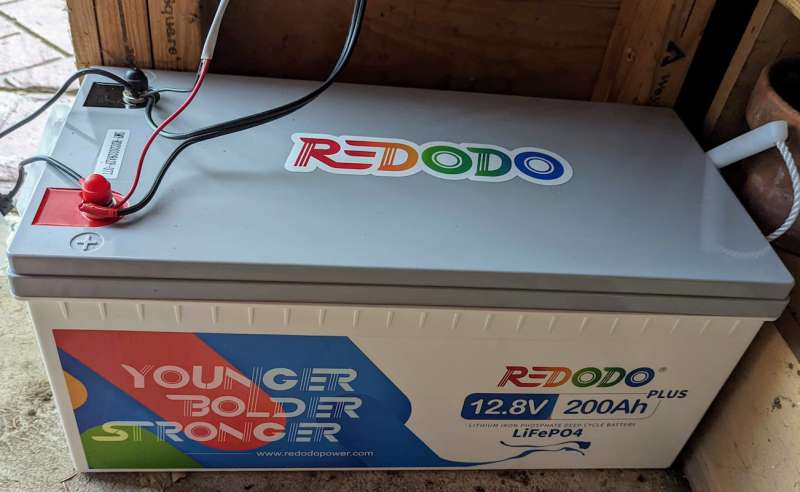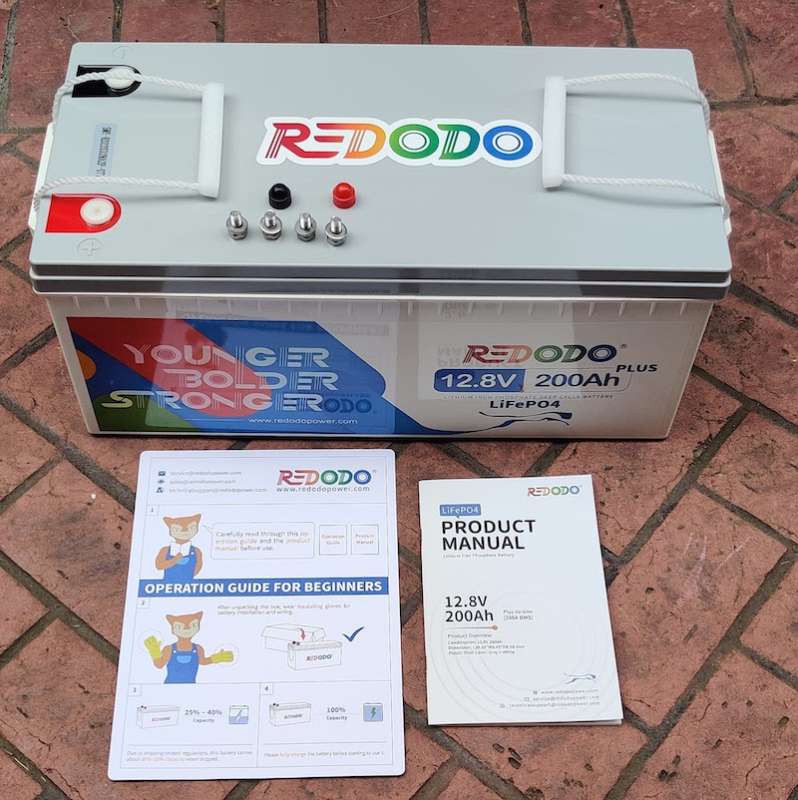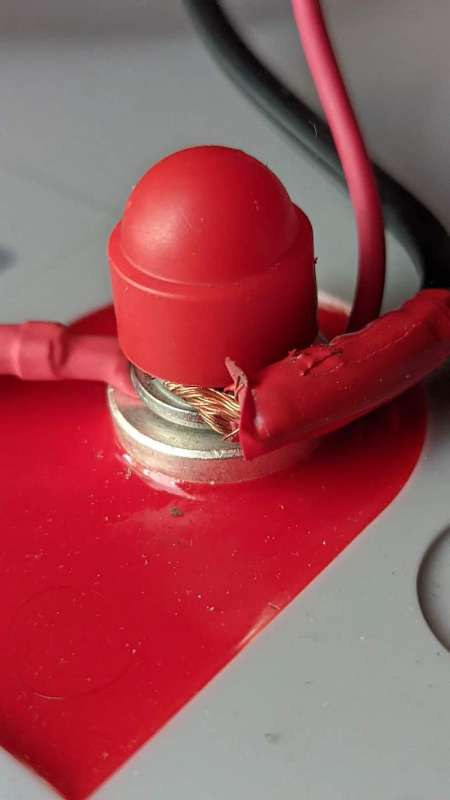
REVIEW – Before the pandemic when I worked in an actual office, our building was powered by the largest solar array in our state. We could park our cars under it, since it covered the parking lot. If you had an electric vehicle, you could charge it up for free. I really enjoyed knowing that the energy I was using at work was largely carbon-free.
When we switched to work-from-home, I missed that, so I decided to reproduce what I had in the office, on a much smaller scale. I built a solar work-from-home setup. One of the main components of any off-grid solar system is a battery. So in this review, I’ll be reviewing the battery I’m using in my setup, the Redodo 12V 200Ah Plus LiFePO4 battery.
If you are looking to build an off-grid system, a van-life setup, a solar shed, or add solar power to your RV, this would be a great battery to consider.
What is it?
The Redodo 12V 200Ah Plus LiFePO4 Battery is a battery. A big one. Not one that can start your car, but you could power a big chunk of your house with it, for a while. It’s a newer battery technology using lithium iron phosphate (LiFePO4), which has a lot of advantages over traditional lead-acid batteries. It’s the same battery technology now used in electric vehicles. The Redodo brand is a rebranding and update of the popular Zoom batteries.
What’s in the box?
- Redodo 12V 200Ah Plus LiFePO4 Battery
- Manual
- Operation guide for beginners
- Two sets of terminal studs
- Terminal covers

Hardware specs
- Voltage: 12.8V
- Usable Energy: 2560 Wh
- Maximum continuous discharge current: 200 amp
- Maximum load power: 2560 W
- Width: 9.37 inches
- Length: 20.5 inches
- Height: 8.54 inches
- Weight: 49.6 lb
- Terminal: M8 16mm bolts
- Maximum expansion: 4 batteries in either parallel or series
- Warranty: 5 years
Design and features
Perhaps the best feature of the Redodo 12V 200Ah Plus LiFePO4 Battery is its value. Battery prices tend to be compared by looking at the price per kWh. The price for LiFePO4 batteries has been falling dramatically over the last decade, largely driven by the increase in electric vehicles and the increased scale of battery production. For the last few years, most LiFePO4 batteries had cost between $300 and $400 per kWh. At a price of $729, this battery comes in well below that, at $285 per kWh. This is using grade-A cells, quality components, and a robust build.
There is a built-in battery management system (BMS) that provides over-discharge protection, over-current protection, overcharge protection, over-voltage protection, short-circuit protection, and thermal protection. It’s unlikely that this battery includes low-temperature charging cutoff built into the BMS. So use caution if the battery will be in an area where the temperature drops below freezing, as lithium batteries can be damaged if charged below freezing. This can be pretty easily fixed for less than $20 with a 12V thermostat.
The Redodo 12V 200Ah Plus LiFePO4 Battery is pretty large and weighs about 50 pounds. This is a LOT less than a comparable lead-acid or AGM battery. The battery has nice rope and plastic handles to make moving it easy, and can actually be used in any position except upside down. The graphics on the battery are colorful and attractive, but it’s unlikely that many people will end up seeing it, as batteries are usually put somewhere out of sight.

Performance
It’s pretty hard to gauge the performance of a battery over a short time span, as performance for most new batteries is good. The real test is over time, but that’s outside of the scope of this review. Additionally, the performance of any battery is partially determined by the system that it’s installed in. My system is an off-grid solar system that runs our outdoor landscape lighting and my work-from home setup (laptop, monitor, speakers, phone chargers, etc).
So far, the Redodo 12V 200Ah Plus LiFePO4 Battery has performed flawlessly. The Renogy solar controller I have is set for lithium batteries so charging from the solar panel is optimized, and my 200W of solar have had no problem keeping the battery topped up to maximum voltage.
This battery is very similar to other lithium batteries out there, and they are all generally known to perform well. Especially when compared to older lead-acid or sealed AGM batteries. In general, LiFePO4 batteries are much safer, are much lighter, and last MUCH longer. Over time, this longer life makes lithium batteries a better value, and at $729, this battery expands that value.
One small gripe about the Redodo 12V 200Ah Plus LiFePO4 Battery is that the included terminal covers do not cover the entire terminal, leaving an opportunity for shorts. This can easily be remedied with some electrical tape, but it seems like a small oversight that could have been easily corrected.
What I like
- All the benefits of lithium batteries at a great price
- Robust, well built
- Grade-A battery cells
- Built-in BMS (but no low-temperature protection)
What I’d change
- Terminal covers do not cover the entire terminal, leaving an opportunity for shorts
- Add a true low temperature charging cut-off to the BMS.

Final Thoughts
Lithium batteries are becoming less expensive, especially when considering their long life compared to older battery technology. And as off-grid and solar systems are becoming more common in both homes, cabins, and vehicles, the benefits of lithium batteries are are needed by more people. The Redodo 12V 200Ah Plus LiFePO4 Battery has a massive capacity at a very reasonable price (for a battery of this size) and would be a great option for a variety of applications. Just be aware that you can’t charge it below freezing without risking permanent damage.
Price: $729.99
Where to buy: Redodo or Amazon
Source: The sample for this review was provided by Redodo Power.



Gadgeteer Comment Policy - Please read before commenting
Does it emit fumes like lead acid batteries?
Lifepo4 batteries doesn’t emit fumes
Afternoon, try battery terminal crimps. And please use bigger size cable from charge controller to battery. Your solar cable is bigger, rather use that. And if your charge controller is adjustable, set for battery specs. Enjoy
I was just thinking when i saw that doorbell wire next to wood, 200w devided by 12v is around 15amps. 10g wire needed like the panel has then. Not doorbell wire
Nope. Its sealed. No fumes, no leaks.
Lithium battery technology doesn’t gas line normal lead acid during the charging cycle.
Hence making them ideal for indoor use, check your code first, it’s recommended to lift any battery off the cold ground to protect them
Only after eating beans.
No they do not and are safe putting in a living space
Please, please what solar charge controller and panels are you using? I’ve been trying to figure out your system for months and get stuck with the solar part. I have the same battery in my Amazon cart along with a charger, inverter and battery cut off switch. But can’t figure out the solar controller and panels.
David, I am using a Renogy Voyager 20A charge controller, and two Rich Solar 100W panels. So far, it’s a great setup!
Hi Danny
12 volts is not a high voltage BUT it will burn a wire out in a very short time and cause fires by overheating if a short circuit or overloading happens.
I notice you have no fuses or 12v breakers from your battery…..this is bad news for you.
A couple of cheap 12v car fuses will do…
Size depends on load in amps ..you dont want to be homeless for few pennies.
Nice article 🙂
Regards Clive UK… England
Thanks Clive. You’re right – the setup you see in the photos was a “quick and dirty” one for the sake of testing the battery. My actual setup is still being built but is all around 10AWG fused wires.
Terrible article, the wiring looks like a bird nest and the connections look like a fire for sure. Misleading by saying this will power everything? In your car or home?? I would love to see this thing bake me a cake while drying my clothes and toasting a pop tart in the toaster while blow drying my hair and cranking my A/C down to 65 degrees.. with all my lights on. . Sure, power everything.
If your house was small and set up to be powered by solar, it probably could power everything. But as a battery backup for a whole-house system, I doubt it. But in that case, very few batteries could accomplish that. And I know the wiring looks amateurish. This was a “quick and dirty” setup to test the battery. The actual system is still being built out but is all around 10awg fused wiring.
Why write a review if you don’t know critical information about the battery, such as whether it has thermal protection? According to a 30 sec Google search that took me to the Redodo website, this battery does have thermal protection. Sloppy work, man.
Hi Dave. Thanks for the comment. The battery does have thermal protection, but only on the high end. There is no low temperature thermal protection. The company does not specify this on their product specs, so I asked them. I was suspicious because batteries in this price range often do not include low-end thermal protection, which is actually really important if you live in a cold area. Unfortunately, their reply did not come in time for the review.
Since i do’nt want to but anything from China: where does redodo come from?
China.
What is the reset procedure for an over current disconnect from the BMS? Has anyone actually test when that happens? I have seen YouTube reviews with a load a bit over 200amps for over 30 minutes without the BMS shutting down. It says it will disconnect with a 400amp load after 5 seconds. If it disconnects does it restart once the load is removed? After a certain period of time? Or some other means?
Thanks